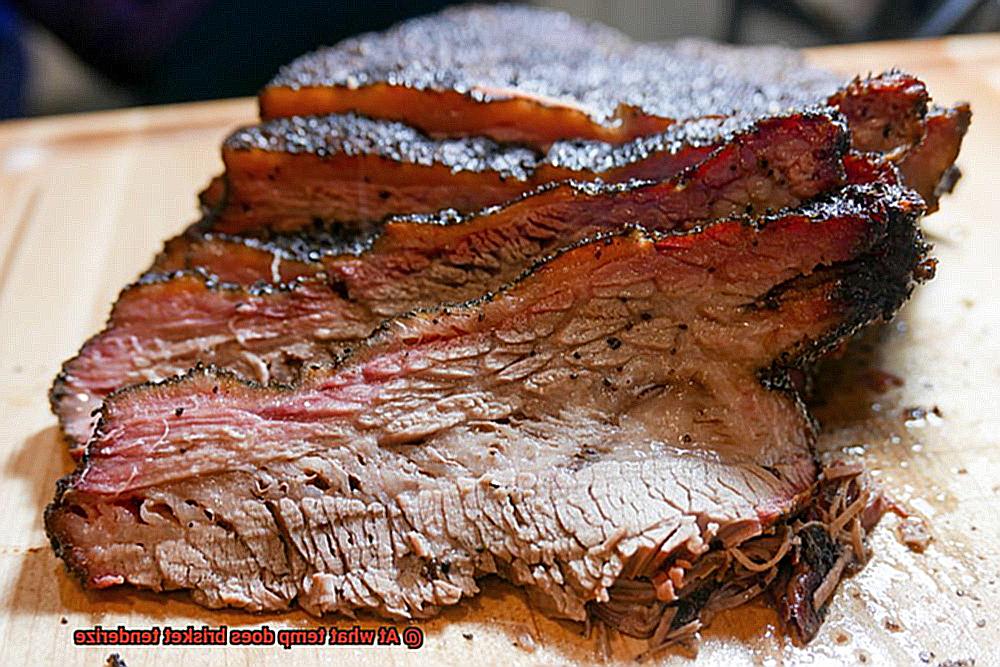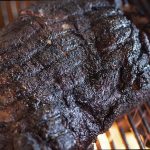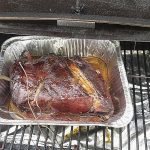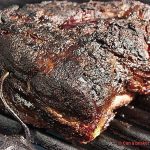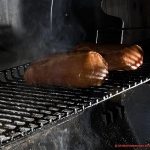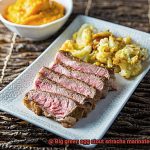Brisket, the holy grail of barbecue, is a meaty masterpiece that tantalizes taste buds and leaves us craving more. But let’s face it, achieving that melt-in-your-mouth tenderness can be a challenge. One key ingredient to unlocking brisket perfection? Temperature.
So, what’s the secret temperature that turns tough brisket into a juicy sensation? It’s a question that has puzzled pitmasters and home cooks alike. In this blog post, we’ll dive deep into the science behind tenderizing brisket and uncover the ideal temperature range.
Join us on this culinary adventure as we combine expertise with passion to unravel the mysteries of brisket tenderness. From understanding the composition of this complex cut to mastering the power of temperature, you’ll gain essential insights to elevate your barbecue game.
So grab your apron, fire up your grill, and get ready to discover the magic temperature at which brisket transforms from stubborn to succulent. Prepare to amaze your taste buds and wow your guests with a brisket that defies expectations.
Contents
What is Brisket?
Prepare yourself for a culinary adventure that will awaken your taste buds and leave your loved ones impressed. Enter the world of brisket, the reigning monarch of grilling. Brisket is a tough yet incredibly flavorful cut of meat that, when treated with care and slow-cooked to perfection, transforms into a juicy and tender masterpiece. In this article, we will delve deep into the secrets of brisket, from understanding its composition to achieving that delectable tenderness.
The Anatomy of Brisket:
Brisket is made up of two primary muscles – the lean and sizable flat, and the more marbled and succulent point. These muscles are enveloped by layers of fat and connective tissue, which contribute to the rich flavor and unique texture that define brisket.
Slow and Steady Wins the Race:
To unlock the full potential of brisket, it requires a slow cooking process at low temperatures. This unhurried approach allows the collagen in the connective tissue to break down into gelatin, resulting in meat that is not only tender but also melts in your mouth.
Preparing for Success:
Before you ignite the flames on your grill, it is essential to trim excess fat from the brisket. This ensures better penetration of seasonings while preventing greasiness. However, leaving a thin layer of fat on top can enhance both flavor and moisture during cooking.
Cooking Methods:
Brisket can be prepared using various cooking methods such as smoking, braising, or roasting. Each technique imparts its own distinct flavors and textures to the meat. For an authentic smoky flavor, smoking is highly recommended.
The Temperature Game:
Monitoring the internal temperature of your brisket is crucial for achieving optimal tenderness. Aim for an internal temperature of around 195°F to 203°F (90°C to 95°C) to attain that perfect melt-in-your-mouth texture.
The Science Behind Tenderizing Brisket
Brisket, the king of the grill, tantalizes with its promise of tender, melt-in-your-mouth delight. But what makes brisket truly tender? Embark on a scientific journey as we unravel the secrets behind tenderizing this flavorful cut of meat.
The Role of Temperature:
Temperature is the maestro orchestrating the tenderization process. As brisket cooks, collagen, those tough connective tissues, transform into gelatin. This metamorphosis infuses moisture and tenderness into the meat, creating a succulent and blissful eating experience. The magic happens between 195°F and 205°F (90°C to 95°C), where collagen breaks down completely, resulting in that sublime melt-in-your-mouth sensation.
Slow and Steady Wins the Race:
Achieving tender brisket isn’t just about reaching high temperatures; it’s also about giving it ample time. Slow-cooking allows for gradual collagen breakdown, ensuring maximum tenderness and flavor development. Smoking, braising, or slow-cooking in an oven or slow cooker are excellent methods to accomplish this culinary masterpiece.
Moisture Matters:
But wait, there’s more. Moisture plays a vital role in tenderizing brisket. Marinades and basting liquids not only infuse flavors but also keep the meat moist during cooking. This moisture aids in breaking down collagen further, enhancing overall tenderness and succulence. Imagine each bite being a symphony of flavors and juiciness.
Size, Marbling, and Quality:
Every brisket is unique, influenced by factors like size, marbling, and meat quality. To ensure your brisket reaches its full potential, use a trusty meat thermometer to monitor internal temperature and guarantee it reaches that sweet spot between 195°F and 205°F. This attention to detail will ensure the perfect harmony of tenderness and deliciousness.
The Resting Ritual:
After the cooking is complete, resist the urge to slice into your masterpiece immediately. Allow the cooked brisket to rest, as if it were taking a well-deserved bow. This resting period allows the juices to redistribute within the meat, resulting in a more flavorful and tender final product. Patience becomes an art form, rewarding you with pure culinary bliss.
Low and Slow Cooking for Optimal Results
Low and slow cooking is a culinary symphony that harmonizes temperature, time, and technique to transform tough cuts of meat into succulent, mouthwatering masterpieces. It’s a flavorful journey that will have your taste buds singing with delight. So, tie on your apron and let’s dive into the enchanting world of low and slow cooking for optimal results.
To begin this culinary adventure, you must set the stage with the perfect temperature. For brisket, the sweet spot lies within the range of 225°F to 250°F. This low and slow approach allows for a gradual breakdown of collagen, the culprit behind chewy cuts. Yes, it may take longer, but trust me, the end result will justify every minute spent waiting.
Now that you’ve found your temperature groove, it’s time to infuse some flavor. Smoke becomes the secret ingredient that elevates your brisket from good to unforgettable. Grab those wood chips or chunks and let their smoky essence weave its magic into every fiber of the meat. Brace yourself for a flavor explosion that will leave your taste buds dancing with joy.
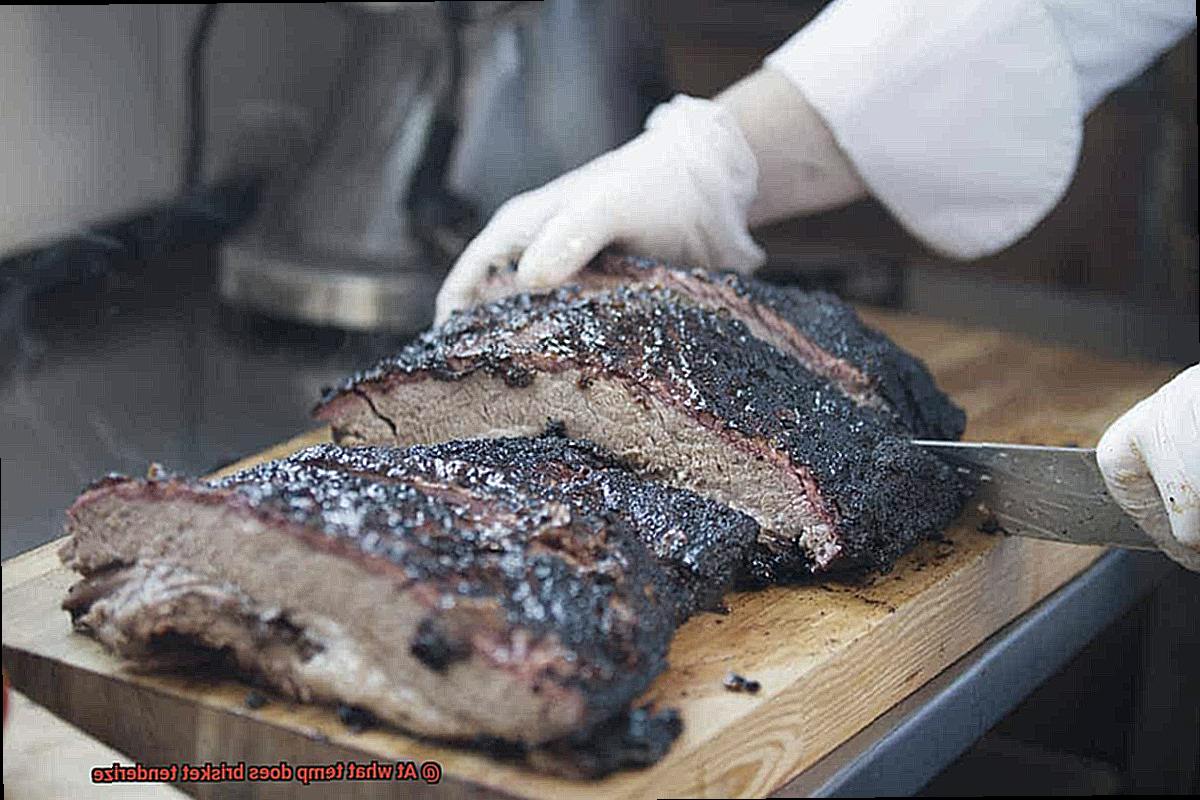
But hold on tight. Consistency is key in the realm of low and slow cooking. The slightest temperature fluctuations can disrupt the tenderizing process and compromise the texture of your brisket. Keep a watchful eye on that thermometer and make adjustments as needed to maintain a steady heat.
Speaking of thermometers, they aren’t just for show. Utilize a meat thermometer to monitor the internal temperature of your brisket. To achieve that melt-in-your-mouth sensation we all crave, aim for an internal temperature around 195°F to 205°F. Once you hit that sweet spot, remove your brisket from its heat source and grant it at least 30 minutes of rest. During this interlude, the juices within the meat will redistribute, resulting in a more flavorful and moist final product.
Temperature Range for Tenderizing Brisket
Prepare to elevate your grilling prowess to new heights as we delve into the art of tenderizing brisket. Today, we will unveil the secret temperature range that will metamorphose your tough cut of meat into a succulent masterpiece. Brace yourself for a tantalizing explosion of flavors that will leave your family and friends begging for more.
Slow and Steady: The Enchanting Method
When it comes to tenderizing brisket, slow cooking methods reign supreme. Smoking or braising your brisket at the right temperature is crucial for achieving that melt-in-your-mouth goodness. So, what is the ideal temperature range? Drumroll, please… It lies between 225°F (107°C) and 250°F (121°C). Within this magical range, the collagen in your brisket gradually breaks down over time, resulting in a tender and flavorful meat that will have everyone clamoring for seconds.
Consistency is Key
Maintaining a consistent temperature throughout the cooking process is vital for even and thorough tenderization. So, keep a watchful eye on that thermometer. Cooking at lower temperatures, below 200°F (93°C), can also tenderize the meat, albeit with a longer cooking time. We recommend cooking your brisket at around 225°F (107°C) for approximately 1 hour per pound of meat. Patience becomes an invaluable virtue when seeking brisket perfection.
The Meat Thermometer: Your Trusted Companion
To ensure you hit the sweet spot of tenderness, forge an alliance with your meat thermometer. It shall be your unwavering companion on this odyssey. Monitor the internal temperature of your brisket as it steadily rises towards perfection. Once it reaches approximately 195°F (91°C) to 205°F (96°C), you can proudly declare your brisket fully tenderized and ready to be removed from the heat source.
Rest, Relax, and Reap the Rewards
Hold your horses. Before you unleash your carving skills, grant your brisket a minimum rest period of 30 minutes. This crucial step allows the juices to redistribute throughout the meat, ensuring maximum tenderness and flavor. Trust me, the wait is worth every succulent second.
Avoiding Overcooking and High Temperatures
Mastering the art of avoiding overcooking and high temperatures is the secret to achieving brisket nirvana, and I’m here to guide you on this delicious journey.
Let’s start by understanding why overcooking can turn your brisket into an unfortunate chewy nightmare. Brisket is a tough cut that requires some gentle coaxing to reach its full potential. Subjecting it to high temperatures can cause the meat to dry out and become tough, resulting in disappointment rather than delight.
So, what’s the magic number? The recommended cooking temperature for a mouthwatering brisket is approximately 225-250 degrees Fahrenheit (107-121 degrees Celsius). This low and slow approach allows the connective tissues and collagen in the meat to gradually break down, resulting in a tender and flavorful end product that will have your taste buds doing a happy dance.
Now that we know the ideal temperature range, let’s dive into the techniques that will help you achieve brisket perfection. First and foremost, embrace indirect heat. This means keeping your meat away from direct flames or heat sources. Whether you’re using a smoker or setting up a two-zone fire on your grill, this method ensures that your brisket cooks evenly and slowly, giving it ample time to become tender without losing moisture.
But there’s more to it. Wrapping your brisket in either foil or butcher paper during the cooking process is a game-changer. This technique helps retain moisture and prevents excessive evaporation, ensuring that your brisket stays juicy and succulent throughout its journey to perfection.
Once your brisket reaches the desired internal temperature (which you can easily monitor with a trusty meat thermometer), resist the temptation to dig in immediately. Instead, let it rest. That’s right, give it a well-deserved break for at least 30 minutes. This crucial step allows the juices to redistribute within the meat, resulting in an even more tender and flavorful final product that will make all your grilling efforts worthwhile.
To summarize, here are the key steps to avoid overcooking and achieve brisket greatness:
- Embrace low and slow cooking at 225-250 degrees Fahrenheit (107-121 degrees Celsius).
- Utilize indirect heat to ensure even and gradual cooking.
- Wrap your brisket in foil or butcher paper to retain moisture.
- Monitor the internal temperature with a meat thermometer.
- Allow your cooked brisket to rest for at least 30 minutes before slicing.
Measuring Internal Temperatures for Perfect Results
Ready to elevate your grilling skills and become a brisket master? To achieve that melt-in-your-mouth perfection, you must delve into the world of measuring internal temperatures. This secret sauce will transform your tough, dry brisket into a succulent masterpiece.
Why is this step so crucial? Let’s break it down:
- Tenderize to Perfection: Brisket starts to tenderize around 160°F (71°C). At this temperature, collagen in the meat breaks down, resulting in a more tender texture. But for brisket nirvana, aim for an internal temperature of 195°F to 205°F (90°C to 96°C). This fully breaks down connective tissues, yielding juicy, succulent bites.
- Choose the Right Tool: Accurate measurement requires a trusty meat thermometer. Consider two types:
- Instant-Read Thermometers: These provide quick and accurate readings when inserted into the thickest part of the brisket. Perfect for those craving instant gratification.
- Leave-In Thermometers: These can remain in the brisket during cooking, allowing temperature monitoring without opening the grill or smoker. Maintain that perfect cooking environment.
- No Bones About It: Avoid touching bones with the thermometer, as it may yield inaccurate readings. Aim for the meaty parts instead, ensuring precision.
- Check Multiple Spots: Briskets can be tricky creatures, with some parts cooking faster than others. To guarantee even cooking and tenderness throughout, measure internal temperatures at multiple spots in the brisket. Each bite will be as amazing as the last.
- Rest and Relax: Once your brisket reaches that magical internal temperature, resist the urge to slice immediately. Let it rest for at least 30 minutes. This allows juices to redistribute throughout the meat, resulting in juicier and more flavorful brisket. Trust me, it’s worth the wait.
Different Factors That Affect the Cooking Time
Cooking time is a crucial element in achieving culinary perfection. Whether you’re grilling a brisket or baking a cake, understanding the different factors that affect cooking time is essential. In this comprehensive guide, we will explore the various elements that can influence how long it takes to cook food. From the thickness and composition of the ingredients to the cooking method and temperature, we will delve into each factor to help you create mouthwatering dishes every time.
Ingredient Thickness:
The thickness of ingredients plays a significant role in determining cooking time. Thicker cuts require more time to ensure even cooking throughout. For example, a thick steak will take longer to reach the desired level of doneness compared to a thin slice of fish. Adjusting your cooking plan according to ingredient thickness is crucial to avoid undercooking or overcooking.
Composition and Density:
The composition and density of ingredients also affect cooking time. Ingredients with higher water content, such as vegetables or fruits, tend to cook faster due to their high moisture content. On the other hand, denser ingredients like meat or root vegetables require more time to cook thoroughly. Understanding the composition of your ingredients allows you to plan your cooking process accordingly.
Cooking Method:
Different cooking methods have varying impacts on cooking time. Grilling, baking, roasting, boiling, or frying all have distinct effects on how long it takes for food to cook. For instance, grilling at high heat requires less time compared to slow-roasting at a lower temperature. Selecting the appropriate cooking method for your dish is crucial in achieving the desired results.
Cooking Temperature:
The temperature at which you cook your food greatly affects cooking time. Higher temperatures tend to expedite the cooking process, while lower temperatures require more time but result in tender and juicier outcomes. Understanding the optimal cooking temperature for specific dishes is vital to ensure the perfect balance between tenderness and flavor.
Quantity and Size:
The quantity and size of ingredients can influence cooking time as well. Cooking larger quantities of food simultaneously may require longer cooking times to ensure even heat distribution. Similarly, smaller or irregularly shaped ingredients may cook faster or slower than expected. Adjusting cooking times based on the quantity and size of ingredients is essential to avoid undercooking or overcooking.
Altitude and Environment:
Believe it or not, altitude and environmental factors can affect cooking time. At higher altitudes, where air pressure is lower, the boiling point of water decreases, leading to longer cooking times for certain dishes. Additionally, factors such as humidity and kitchen equipment efficiency can impact how long it takes for food to cook. Being aware of your environment allows you to make necessary adjustments in cooking time.
8OiaypcnXDk” >
Conclusion
In conclusion, the path to tender and mouthwatering brisket is paved with precision and temperature mastery. The sweet spot for brisket tenderness lies within the enchanting range of 195°F to 205°F (90°C to 95°C). Within these fiery confines, collagen surrenders its tough demeanor and transforms into a luscious gelatin, rendering your brisket irresistibly melt-in-your-mouth.
To unlock this tantalizing tenderness, one must embark on a slow and low cooking odyssey. This leisurely journey allows for the gradual breakdown of collagen, while simultaneously coaxing out the flavors that lie dormant within. Whether you choose to smoke, braise, or roast your prized brisket, unwavering temperature control is paramount.
The vigilant monitoring of your brisket’s internal temperature with a trusty meat thermometer becomes your compass on this epicurean expedition. Aim for an internal temperature that dances between 195°F to 205°F (90°C to 95°C) before triumphantly removing your brisket from its fiery abode.
But hold your culinary horses. Before indulging in the succulent spoils of victory, bestow upon your cooked masterpiece a well-deserved rest for no less than 30 minutes. This respite allows the precious juices to mingle harmoniously within the meat, culminating in a symphony of flavor and tender perfection. Remember, dear chef, patience is truly a virtue when it comes to achieving brisket nirvana.
Beware. The treacherous path of overcooking and scorching temperatures lies in wait. Journeying beyond the boundaries of 225-250 degrees Fahrenheit (107-121 degrees Celsius) risks desiccating your beloved brisket and transforming it into an unyielding titan of toughness.
Armed with this sacred knowledge of temperature alchemy, you possess the power to elevate your grilling prowess to celestial heights.

